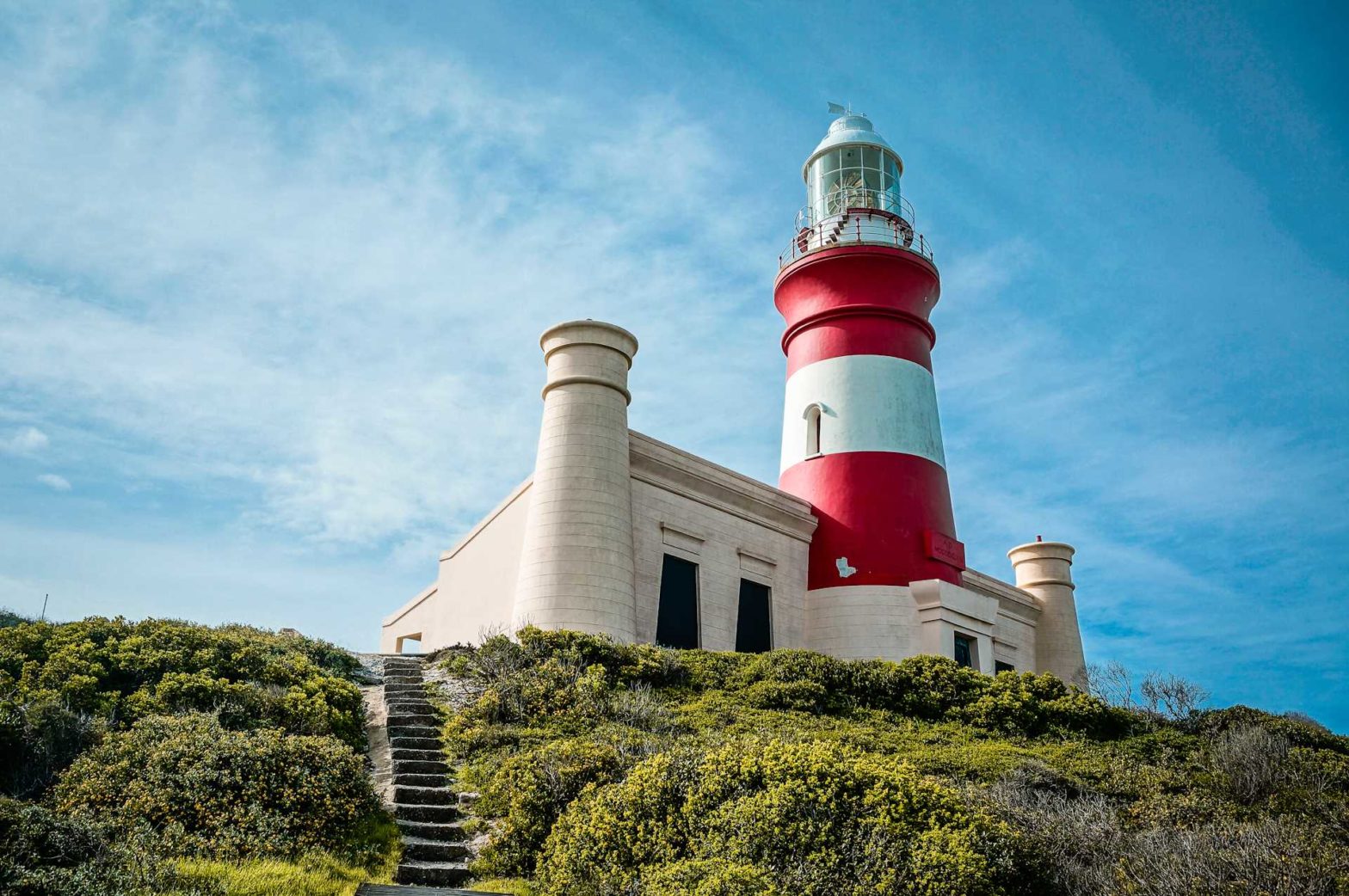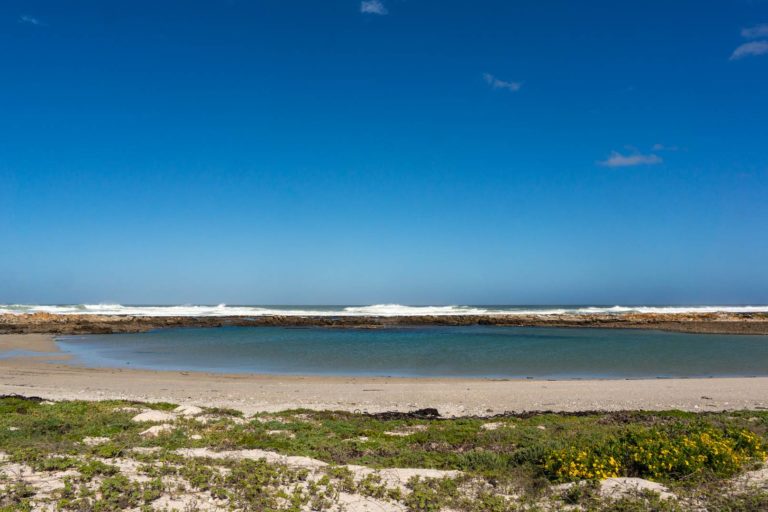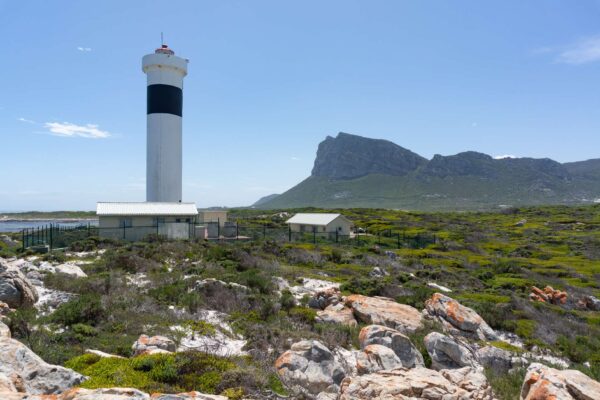By Tom · Published Feb. 23rd, 2021 · Updated Nov. 23rd, 2022
Go on a hike from the historic Cape Agulhas Lighthouse, see a shipwreck and explore the southern tip of Africa. You’ll also see many seabirds and have great views over the ocean from the inland ridge on the walk back. Part of this hike is also known as the Rasperpunt Hiking Trail.
Location
Cape Agulhas is located along the southern coast of Western Cape, South Africa. It is a 223 km drive from Cape Town along the N2, R316 and R319, which takes you about 2.5 to 3 hours. You can stop on the way for instance in Napier or in the town of L’Agulhas for a drink or bite. This walk starts at the Cape Agulhas lighthouse car park inside the SANParks Agulhas National Park.
Cape Agulhas Lighthouse Hike Map
Get the route by downloading the .gpx or .kml file below. For navigation with Maps.me on your mobile phone, simply download the .kml file and open to add it to the Maps.me bookmarks.
We did this hike as part of a weekend trip from Cape Town, and this trip report has more details on where to stay and what else to do in the region. We started this hike at the lighthouse, but the official hike (Rasperpunt Hiking Trail) does actually start by the shipwreck. And then you have to follow the white footprint markers. At the numbers, the leaflet provided by the SANParks reception will give you mildly interesting facts about where you are. You will find the reception on the right before you enter the park.
Tips
- Bring a sunhat and sunscreen, even though it is not often very warm, the sun is still bright.
- Ask at the SAN Parks office for a kind of map with descriptions.
- Keep an eye out for the markers – they are sometimes not clear, MapsMe can be useful.
- If you want a shorter hike, you can drive from the lighthouse to the shipwreck and start there.
- You can stay in the Park or there are several cheaper options nearby*.
- Find more great hikes in South Africa.
Agulhas Lighthouse Museum
We started our walk with a visit to the lighthouse museum. It tells you about the history of the lighthouse and it also has a good overview of other famous lighthouses all over the world. It was quite interesting, also for non-lighthouse enthusiasts. You can finish off by going to the top of the lighthouse for a wonderful panorama of the coastline.
History of the Cape Agulhas Lighthouse
The Cape Agulhas lighthouse is one of South Africa’s national monuments. It is the second oldest working lighthouse in the country. This lighthouse is very necessary because of the treacherous seas around this point. The shipwreck along this hike is proof of that, and is one of many.
The construction of the lighthouse began in 1947 and it started operating in 1849. The lighthouse is constructed out of limestone and it has a very distinct architecture. Its design is based on the ancient Lighthouse of Alexandria on the island of Pharos, one of the Seven Wonders of the Ancient World. The Cape Agulhas Lighthouse has a striking design, although I can’t really say it looks like that of Alexandria, especially considering that the Alexandria one has a tower of 103 to 118 m!
Southern most Point of Africa
After the museum, we walked along the coast to the actual Cape Agulhas. Unlike popular belief, not Cape Point but Cape Agulhas is the southernmost point of Africa. It also forms the dividing line between the Atlantic and Indian Oceans. Nearby, there is a nice map of Africa on the floor, showing all the mountains in a 3D relief.
We continued our hike to the shipwreck. This was the Meisho Maru No. 38, a small Japanese fishing vessel, that was stranded here in 1982. From here, the official hike with white markers starts. From the shipwreck, the hike goes first along the coast, through the bushes. Then the path heads inland, across the road, and up to the top of the ridge.
Path On the Ridge
From the ridge, you can see strange structures jutting out into the ocean. The strange sandbanks below are, as they look, man-made. They were used to help catch fish. The barriers are such there is a narrow space in between them – when the tide comes in, fish come in too. Then when the tide begins to go out, fishing nets can be strung between the sandbanks to trap the fish. Very cunning.
On the ridge, in places it is hard to see the trail markers – so keep a sharp eye out! But basically you just head along the edge of it, and then head back down to cross the road and end up back at the shipwreck. Then it is back the way you came to the lighthouse or along the road. Afterwards, we headed to a restaurant just outside the park for lunch. We then got the key to our accommodation at the National Park rest camp, drove there, and did another hike along the coast.
Find out more about Agulhas National Park, explore nearby de Hoop Nature Reserve, or discover more hikes in South Africa.





